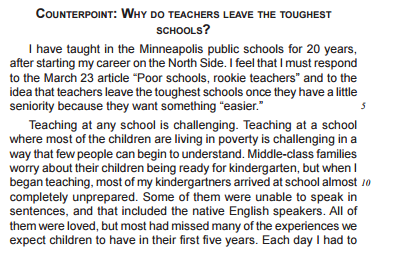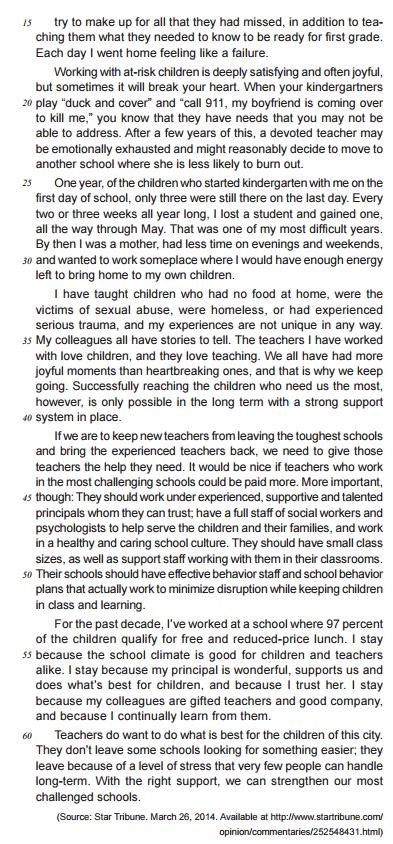Questions 21 through 35 address existing theories of English teaching.
Read them and mark the correct alternative.
In “Teaching Reading Skills in a Foreign Language”, Nuttall
(1996, p. 39) presents some reading strategies. According to the
author, some of them are obvious and some are more complex.
The correct correspondence between the strategy and the type is:
According to the Longman Grammar (Biber et al., 1999), it is diffi cult to identify the intended time reference for the past perfect, because the reference depends on the context. In “All of them were loved, but most had missed many of the experiences we expect children to have in their fi rst fi ve years.” (l. 12), the time reference for the past perfect verb phrase is:
Questions 46 through 50 present some problems English learners
usually have. Mark the correct alternative for each question.
Suppose you are correcting some literary essays. In one
essay, you fi nd the following extract.
“It begins with the Giant coming back to his garden after a
seven-year trip. When arriving they see that children play in his
garden.” (source: a real student’s essay)
The mistake that directly affects the cohesion of the extract is the/a:
Questions 21 through 35 address existing theories of English teaching.
Read them and mark the correct alternative.
The “Parâmetros Curriculares Nacionais” claim that learning
a foreign language contributes to the learning of the fi rst language.
According to this document, that can be explained by the fact that
learning a foreign language:
Questions 21 through 35 address existing theories of English teaching.
Read them and mark the correct alternative.
When teaching vocabulary, teachers should be aware of the purpose of the activities they propose. Harmer (2007) presents some examples of vocabulary activities associated with a specific purpose. One example of correct association between the activity and its purpose is:
Lexical choices vary according to the different types of language: written or spoken. An example of a word in the text that is typical of American conversational English is:
One mechanism of grammatical cohesion is the use of substituting pro-forms. The only example of a pro-form is:
Questions 46 through 50 present some problems English learners
usually have. Mark the correct alternative for each question.
Suppose a student asks you if ‘whose’ in the following
academic passage is wrong.
“There is a way of proceeding in conceptual matters whose
method is to defi ne away any inconvenient diffi culty.” (Biber et al,
1999, p. 617)
The alternative with the correct answer and comment is:
Questions 21 through 35 address existing theories of English teaching.
Read them and mark the correct alternative.
In “Dimensões Comunicativas no Ensino de Línguas”, Almeida Filho (2007) discusses the types of competence a language teacher should achieve. For the author, “implicit competence” is the most basic one and should be surpassed. This competence can be defi ned as a/an:
Questions 21 through 35 address existing theories of English teaching.
Read them and mark the correct alternative.
The “Currículo Mínimo – Língua Estrangeira” (2012) has the purpose of developing the following competence in basic school education:
Questions 21 through 35 address existing theories of English teaching.
Read them and mark the correct alternative.
According to Harmer (2007) in “How to teach English”, the
discovery approach is a possible way of teaching grammar. In this
approach, teachers lead learners to build the target knowledge.
One example of a discovery activity is:
In the sentence “It would be nice if teachers who work in the most challenging schools could be paid more.” (l. 43), the personal pronoun ‘it’ functions as an:
According to the Longman Grammar (Biber et al., 1999, p. 988), “collocations are associations between lexical words, so that the words co-occur more frequently than expected by chance”. This text presents several examples of collocations. The only exception is:
Modal verbs can be classifi ed into two major categories of meaning: epistemic and deontic. Epistemic modals refer to the logical status of events or states. The following alternatives are examples of epistemic modals. The only exception is:
Questions 46 through 50 present some problems English learners
usually have. Mark the correct alternative for each question.
Learners of English as a foreign language usually have
problems in distinguishing between oral and written English. Oral
language typically displays an unplanned and fragmented speech,
while written language usually presents a more elaborated and
planned speech. When correcting written assignments, teachers
should pay particular attention to the uses that are typically oral.
The alternatives below present examples of oral speech. The only
exception is:



